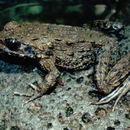Description
(
Inglês
)
fornecido por AmphibiaWeb articles
Vomerine teeth present. Posterior part of the tongue free and forked. Toes webbed. Omosternum and sternum ossified. Pupil of the eye horizontal. Inner metatarsal tubercle small. Snout moderately sharp. Male vocal sacs reduced. No temporal spot. Dorsal coloration brownish-grey or earth-grey, without pattern. Dorso-lateral folds absent. The skin on the back, sides of the body, and legs covered with numerous very distinct, longitudinally orientated, short wrinkles.Some researchers consider Chinese populations to belong to the separate species, Rana emeljanovi. However, it is more reasonable to retain this species name until the clarification of the taxonomic relationships between these forms is clarified. This species was featured as News of the Week: January 7, 2019: How sex is determined in frogs is complicated. In some species, males have two different sex chromosomes (an XX-XY sex chromosome system, like mammals) whereas females of other species are the sex with two different sex chromosomes (a ZZ-ZW sex chromosome system, like birds). Whether a species has an XX-XY or ZZ-ZW system has changed dozens of times throughout frog evolution. The Japanese wrinkled frog (Glandirana rugosa) is an evolutionary witness to the remarkable complexity of frog sex determination. Some populations have an XX-XY sex chromosome system whereas others have a ZZ-ZW system. In central Japan, there are adjacent populations of wrinkled frogs with different sex chromosome systems. Ogata et al. (2018) recently discovered a hybrid zone where these two populations meet. They found here a ZZ-ZW system but also a hybrid sex chromosome system. In this hybrid population, the Z-chromosome is partially derived from the old ZZ-ZW population’s Z-chromosome and partially derived from the XX-XY population’s Y-chromosome. The hybrid population’s W-chromosome is surprisingly derived from the X-chromosome of the XX-XY population. This work illustrates how the fantastic diversity of sex determining systems in frogs can arise from recycling sex-determining genomic material across populations and species (Written by Max Lambert).
Kostin, A.A. (1943). ''Some notes on the Wrinkled Frogs Rana rugosa Schlegel and Rana emeljanovi Nikolsky in Manchuria.'' Bull. Inst. Sci. Res. Manchoukuo, 7(2).
Distribution and Habitat
(
Inglês
)
fornecido por AmphibiaWeb articles
The species is distributed in Japan (northern, middle and southern parts of Honshu Island, as well as on the islands Shikoku, Kyushu, Sado, Oki, Goto, Yakushima, Tsushima and Tanegashima), Northern and Southwestern Korea, and Northeastern China (provinces of Liaoning, Jilin and Heilongjiang). The frog inhabits mountainous and plain landscapes covered with herbaceous and arboreal vegetation: swamps, ponds, rice fields, springs, streams etc.
Life History, Abundance, Activity, and Special Behaviors
(
Inglês
)
fornecido por AmphibiaWeb articles
Poorly known.
Japanese wrinkled frog
(
Inglês
)
fornecido por wikipedia EN
The Japanese wrinkled frog (Glandirana rugosa) is a species of true frog native to Japan and introduced to Hawaii in the late 19th century. It has sometimes been regarded as a single species with the Imienpo Station frog (Glandirana emeljanovi) which is found on the East Asian mainland. The two species are distinguished from others by their rough and uneven skin. It lives and breeds in various freshwater environments, including ponds, streams and wetlands. The IUCN does not consider this species to be faced by any significant threats.[1]
References

- licença
- cc-by-sa-3.0
- direitos autorais
- Wikipedia authors and editors
Japanese wrinkled frog: Brief Summary
(
Inglês
)
fornecido por wikipedia EN
The Japanese wrinkled frog (Glandirana rugosa) is a species of true frog native to Japan and introduced to Hawaii in the late 19th century. It has sometimes been regarded as a single species with the Imienpo Station frog (Glandirana emeljanovi) which is found on the East Asian mainland. The two species are distinguished from others by their rough and uneven skin. It lives and breeds in various freshwater environments, including ponds, streams and wetlands. The IUCN does not consider this species to be faced by any significant threats.
- licença
- cc-by-sa-3.0
- direitos autorais
- Wikipedia authors and editors

